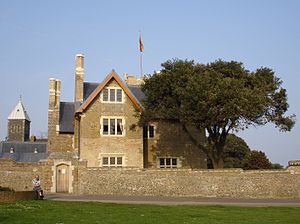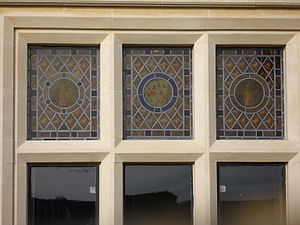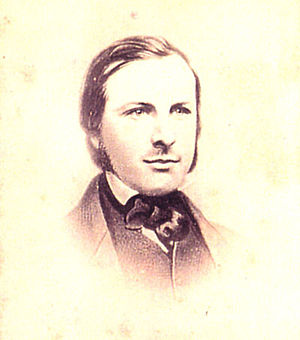The Grange, Ramsgate: Difference between revisions
imported>Russ McGinn No edit summary |
imported>D. Matt Innis m (The Grange, Ramsgate/draft moved to The Grange, Ramsgate: move to namespace) |
Revision as of 18:09, 10 September 2007
The Grange is an architecturally significant house originally built during 1843-44 by and for the architect A.W.N. Pugin in Ramsgate, England, with later additions by his son, E. W. Pugin. The interiors took longer to complete and Pugin died in 1852, just two years after they were finished.[1] It was given Grade I listed building status in 1968.[2]
A.W.N. Pugin, a catholic convert and moralist, built the house to explore and develop his architectural ideas, and to demonstrate, by example, how his notion of an idealised medieval society, and particularly how that society built its architecture, could be realised. In the planning of its spaces, the manner in which the spaces are expressed in elevation, and its neo-gothic style, the Grange occupies a crucial place in the development of 19th Century domestic architecture.[2] The family home was not conceived as a dwelling isolated from the society of the day, but rather that a perfected ideal of a good and moral society would be constructed around it. To this end A.W.N Pugin also purchased sufficient land to construct an adjacent priory and church.[3]
- Pugin's credo of plainness, simplicity and severity
- Eight children, careless with wives [4]
Context
The need for a new type of housing
Pugin's England had been experiencing great social and technological changes. The advent of the railway and suburbanisation meant that the middle classes no longer needed to live in close proximity to their place of work. A new type of housing was needed to accomodate the new, moderately wealthy class of commuter that was somewhere between the stately homes of the upper classes and cottages and more humble dwellings of the lower classes.
Pugin's first experiments had been made at his first house, called St. Marie's Grange, in Salisbury between 1835 and 1837.
Pugin's philosophy and the Neo-Gothic
The Battle of the Styles - classical='pagan' - morality - romantic historicism - decorative (Rococo Gothick) and then scenic (Picturesque Gothic) becoming Pugin's Moral gothic - Not a copyist! -
The Pugin Philosophy
1. Pugin argued that the plan of a building must be a reflection of its function. He wrote “It will be readily admitted, that the great test of Architectural beauty is the fitness of the design to the purpose for which it is intended, and that the style of a building should so correspond with its use that the spectator may at once perceive the purpose for which it was erected.”[5]
2. The True Principles of Pointed or Christian Architecture, eschewed decoration except where it "enriched construction"[4]
3. Gothic architecture was the only true style for a Christian society because it was the one true style of the God-given Church.
Catholic Relief Act 1829 of 1829, Reform Act of 1832, Slavery Abolition Act of 1833 - Britain in flux - industrialisation
Architecture
Built by George Myers[6]
Gault Clay brick with black brick bands, stone dressings and slate roofs. Two storeys with attics. Irregular and picturesquely massed facades, illustrating Pugin's belief in expression of plan and function on elevation. Tripartite garden front has crest returned gable with 2 storey canted bow with casement windows, 2 light attic basement. Centre with 2 ground floor case windows, one first floor single and one 3 light window. Ground floor plinth, first floor string, simple boarded eaves and verges to gables. One 3 light dormer, one ridge stack. Three storey rectangular tower at east with battlemented parapet, single storey hipped roof projecting chapel beyond with one 2 light south and one 2 light west window. Projecting gable at west, addition by E. W. Pugin, forming his business room with external access. Plinth of dismantled conservatory. Highly irregular north front with glazed entrance corridor projection by E. W. Pugin replacing that at right angles to west connecting with original wicket gate entrance. Service wing at north west heightened by E. W. Pugin. Interior: hall with off-axis fireplace, stairs and gallery. Dining room with carved fireplace with brackets supporting large bresummer beam forming inglenook, a reference to the medieval hall-house plan. Two reception rooms with stencilled ceilings with mottoes and heraldry, 2 Pugin fireplaces, one with outer colonnette additons by E. W. Pugin, one with monograms and saints' emblems of the children. Chapel has early Minton tiles and Wailes glass with family portraits and patron saints. The house occupies a crucial place in the development of Cl9 domestic architecture, in planning and style (See BOE, Kent I, 1983 424-5; Dixon and Muthesius, Victorian Architecture, 48-9; St Augustine's Guide). (IOE)
Planning
The arrangement of the Grange's rooms was very unusual for the period. Pugin designed the house with a "pinwheel" arrangement of rooms around a square double height entrance hall and stairwell. The principle rooms were sized, located and orientated according to the requirements of their use and resulted in a deliberately assymetric organisation. Contrast with classical approach[1]
Interior design
Tower
The crenelated tower, from where Pugin would look out for shipping in distress, was originally designed with an enormous spire, as evidenced by Pugin's sketches. Budgetry constraints however necessitated the eventual form.Template:Cn
Alterations by E.W. Pugin
Legacy
- Arts and crafts movement
- Functionalism (architecture)
- Red House (London)?
- Norman Shaw?
- C.F.A. Voysey? perhaps the free plan
- Herbert Tudor Buckland?
- "Butterfield, Scott and Street" George Gilbert Scott, William Butterfield, George Edmund Street [4]
- The True Principles of Pointed or Christian Architecture, eschewed decoration except where it "enriched construction"[4] See Charles Rennie Mackintosh "decorated construction not constructed decoration"
- J. G. Grace & Sons, with whom he had collaborated in design of wallpapers, fabrics, and schemes of decoration." J. Hardman & Co., a Birmingham firm, created ecclesiastical metalwork following his designs, thereby extending his influence. -
Restoration
See also
Citations
- ↑ 1.0 1.1 The Landmark Trust - The Grange
- ↑ 2.0 2.1 Images of England
- ↑ Landmark trust
- ↑ 4.0 4.1 4.2 4.3 Telegraph - A fitting monument to a great architect
- ↑ (A. W. N. Pugin, Contrasts: or, A Parallel Between the Noble Edifices of the Middle Ages, and Similar Buildings of the Present Day, &c. &c. &c. 2d ed. (London, UK: Charles Dolman, 1841; reprint, New York: Humanities Press, 1973), p.1.)
- ↑ Canterbury Archaeological Trust Limited p.29
References
- Mallgrave, Harry Francies [18-04-2005]. Modern Architectural Theory: A Historical Survey, 1673-1968 (Hardback, in English), Second. Cambridge: Cambridge University Press, p.522. ISBN 0521793068.
- Fletcher, Sir Banister, [first published 1896, current edition 2001] A History of Architecture on the Comparative Method, Elsevier Science & Technology, ISBN 0750622679
- Pugin.com
- Guardian
- BBC nosey charlie
- BBC
- Pugin Society
- floor plan
- Time team (god save us!) - channel 4
- Pugin's small houses, Rosemary Hill
- Wallpaper goes to the V&A
- Archaeological excavation for the missing gatehouse


